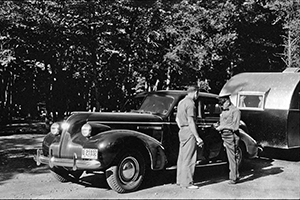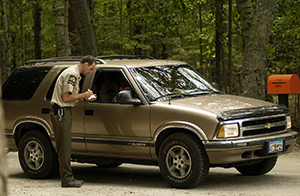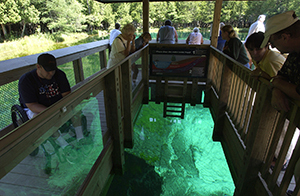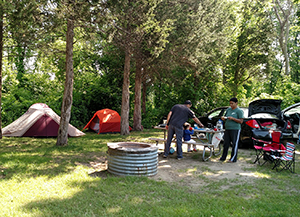|
This is part of a series of stories to mark the centennial of Michigan state parks. On May 12, 1919, the Michigan Legislature established the Michigan State Park Commission, paving the way for our state parks system. The Michigan Department of Natural Resources is celebrating this milestone throughout the year with special events, podcasts, historical stories, videos, geocaching and more. Find more details at Michigan.gov/StateParks100.
Cars, support for state parks and the Recreation Passport
By CASEY WARNER
Michigan Department of Natural Resources

Michigan state parks officially celebrated their 100th birthday earlier this month, May 12. With the establishment of the Michigan State Park Commission on that date in 1919, the story of our state parks system – today 103 parks strong, with 28 million annual visitors – began.
It’s a story that can’t be told without talking about cars, as the automobile industry drove development of Michigan’s state park system.
Early in its history, the question of how to finance continued growth of that system – and whether funding should be tied to the vehicles traveling to parks – was raised.
Initial state park development was dependent on gifts of lands by donors, but if expansion was to continue, there was a realization that the state would need a long-term funding source to purchase more land.
On the topic of financing state park lands, the Biennial Report of the Michigan Department of Conservation for 1925/1926 said, “…since our State Park system is almost entirely an outgrowth of the automobile, it appears that the cost of sites could be best and most fairly met by revenue from car licenses or gasoline.”
Michigan residents and visitors loved the state’s developing system of parks.
|

As automobiles and the interstate highway system connected parks and tourists more than ever before, the state parks system was unable to meet the demand of growing attendance and needed more funding.
In 1957, the state Conservation Commission asked the Michigan Legislature’s permission to set up a park fee system – an annual vehicle sticker, the predecessor of today’s Recreation Passport.
|

These windshield stickers, priced at $2 a year or 50 cents for a daily sticker, allowed unlimited vehicle access to state parks and replaced the previous per-individual park entry fees. Sticker sales were intended to help finance improvements to the parks system, as well as add more parks.
Two of Michigan’s neighbors, Minnesota and Ontario, had pioneered similar sticker plans that were the inspiration for Michigan’s vehicle permits.
|
When the stickers first were proposed, there was strong agreement that the parks system needed more revenue. In fact, the Conservation Commission based its recommendation on a survey of 4,700 park users, which showed that only one in 12 opposed charging a fee for using parks.
A 1956 editorial in the Bay City Times read:
“Common sense, as well as polls of tourists, indicate that fees for admission to our state parks such as our natural parks charge would be gladly paid. Some such program for financing expansion, improvements and maintenance of our state's greatest natural resources — its beauty and play advantages — must he found soon if their proper development is to be achieved.”
However, the road to implementing the vehicle sticker system was an uphill one, with sticker legislation in both 1957 and 1959 vetoed by then Gov. G. Mennen Williams because of concerns about transferring the cost of park improvement to users.

In 1960, the Legislature passed yet another version of the bill, which was not vetoed. By 1968, the annual vehicle permits had become an important source of revenue supporting Michigan state parks.
By 2010, it cost $24 to get an annual vehicle sticker.
Back then, the parks system was in dire straits, having stopped getting support from tax dollars when state parks were removed from the General Fund in 2004.
“At that time the parks were facing a $300 million-plus infrastructure deficit – meaning it would cost more than $300 million to make the needed restorations to existing buildings, campground utilities, roads and historic sites,” DNR Parks and Recreation Division Chief Ron Olson said. “Camping fees were unable to generate enough money to sustain operations, and combined with the infrastructure deficit, many historic facilities began to fall into disrepair.”
The Citizens Advisory Committee for Michigan State Parks, created in 2005 and charged with finding a long-term funding solution to ensure Michiganders could continue using the parks, was instrumental in developing and advocating for the current state parks funding model.
|

In partnership with the advisory committee, the Michigan Department of Natural Resources proposed the Recreation Passport. The passport would be tied to the vehicle registration process and required for vehicles entering state parks.
Olson said that the theory was that reducing the cost of the annual state park pass and offering it to all vehicle owners when they renew their license plates would lead to an increase in the number of people who chose to support parks and in funding.
“And it worked,” he said.
In October 2010, Michigan residents saw the last of the previous $24 window stickers in favor of the new Recreation Passport. Priced at just $10 and providing year-round access to all state parks, the Recreation Passport was a success. In its first year, the passport was purchased for almost 25 percent of the vehicles registered in Michigan, generating $7 million more for state parks than the previous year.
Today, the $11 Recreation Passport – the purchase price was raised in 2013 based on a statutory requirement that it must keep pace with inflation – helps fund maintenance and improvements at Michigan’s 103 state parks, state forest campgrounds, trails and boat launches.
Passport sales also provide funding for local park improvements via Recreation Passport grants, historic sites within state parks, and outdoor recreation facilities and opportunities.
Recreation Passport sales make up 23 percent of state park funding. Other funding sources include camping and lodging reservations (39 percent); oil, gas and mineral royalty revenues (30 percent); concessions and shelter reservations (3 percent); and miscellaneous other sources (5 percent).
|

More than 30 percent of Michigan’s drivers check “Yes” for the Recreation Passport when registering their vehicles.
"The Recreation Passport really is a tremendous value for Michigan residents," Olson said. "For just $11, you get year-round access to more than 103 beautiful, spacious and scenic places to explore the great outdoors, reconnect with family and friends, and get reacquainted with Michigan's incrediblenatural and cultural resources."
In this centennial celebration year of the Michigan state parks, despite creative efforts to develop a new revenue stream, a funding gap continues between money available to make park improvements and the cost of needed upgrades and repairs.
DNR Director Dan Eichinger cites finding solutions to this problem among his top-drawer priorities.
Eichinger said the centennial reminds us of the century-old heritage of state park development across Michigan. The downside of that benchmark is a reminder that Michigan has a 100-year-old park system with a bulging backlog of unfunded park maintenance and improvement projects.
“I’m concerned that at some point that’s going to crush the park system,” he said.
In addition to looking back on state parks’ storied past and celebrating how far they have come in the last 100 years, the centennial also offers an opportunity to look toward the future of state parks and how to ensure they continue to thrive.
During the centennial year, the “Give 100” fundraising effort offers those who love Michigan’s state parks a chance to contribute toward improvements at their favorite parks.
There are also opportunities to buy products that help raise awareness and support for state parks, trails and waterways – posters, T-shirts, ice cream, Stormy Kromer hats, totes, patches and more, some highlighting the centennial – through These Goods Are Good for Michigan.
Read a story on the centennial celebration to learn more about the many ways the DNR is celebrating 100 years, and looking towards the next 100 years, of Michigan state parks.
From its nascent beginnings, with the development of auto-touring and public demand, Michigan’s state parks have faced funding challenges which have been at least temporarily met through new ideas.
Looking ahead, the challenges are significant, but Michigan has been down this road before. The future holds hope that these funding shortfalls will be surmounted, allowing the Great Lakes State to one day celebrate a glorious bicentennial of its beloved state park system.
For more information about the Recreation Passport, visit Michigan.gov/RecreationPassport.
|
Check out previous Showcasing the DNR stories in our archive at Michigan.gov/DNRStories. To subscribe to upcoming Showcasing articles, sign up for free email delivery at Michigan.gov/DNR.
/Note to editors: Contact: John Pepin, Showcasing the DNR series editor, 906-226-1352. Accompanying photos and a text-only version of this story are available below for download. Caption information follows. Credit Michigan Department of Natural Resources, unless otherwise noted.
Text-only version of this story.
Belle Isle: The $11 Recreation Passport gives visitors year-round admission to 103 Michigan state parks, including Belle Isle Park in Detroit, pictured here.
Bikers: In addition to state parks, the Recreation Passport offers access to thousands of miles of trails as well as hundreds of boat launches, state forest campgrounds and other destinations.
Camping1 and Camping2: A time-honored Michigan tradition, hitting the road and heading to a state park for a camping trip is as popular a family pastime today as it was decades ago. Shown here are campers at Otsego Lake State Park near Gaylord in 1956 (photo courtesy of Archives of Michigan) and at Oakland County’s Proud Lake State Park in 2018.
Car1 and Car2: Entrance to – and funding for – Michigan’s state parks has long been tied to cars, from an annual vehicle windshield sticker that was used from 1960 through 2010 to today’s Recreation Passport.
Holland: The entry booth at Holland State Park in Ottawa County is shown here as part of a promotional piece for the Michigan state parks annual motor vehicle permit from 1961, just after the vehicle sticker system had been implemented.
Mears1 and Mears2: The advent of automobile travel in the first half of the 20th century meant more Michigan residents and visitors could enjoy scenic outdoor locations like Mears State Park in Oceana County, still a favorite spot for today’s tourists.
Palms Book and Porkies: The Recreation Passport is travelers’ ticket to some of Michigan’s most unique outdoor destinations, like Palms Book State Park in Schoolcraft County – home to Kitch-iti-kipi or the “Big Spring” – and Porcupine Mountain Wilderness State Park in the western Upper Peninsula, where visitors can enjoy spectacular sights like the Lake of the Clouds scenic overlook./
|